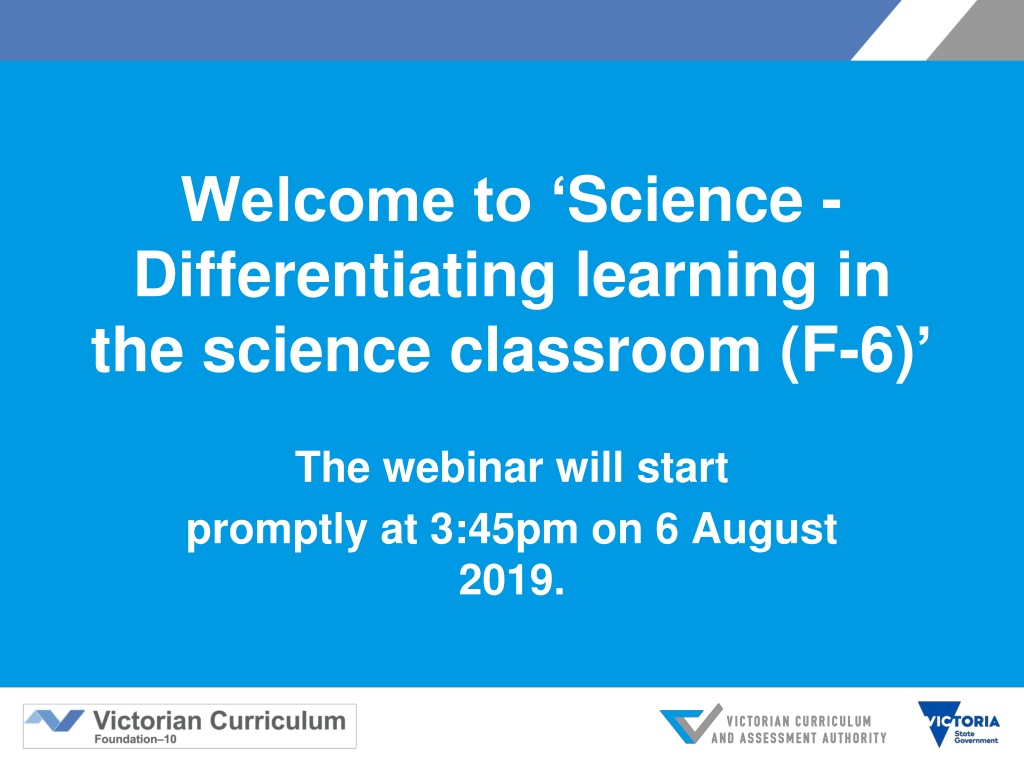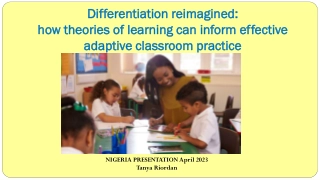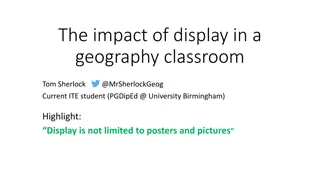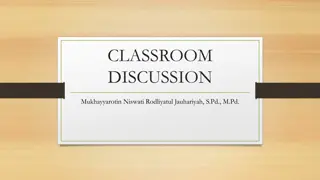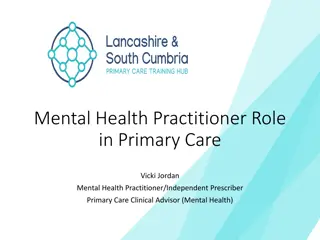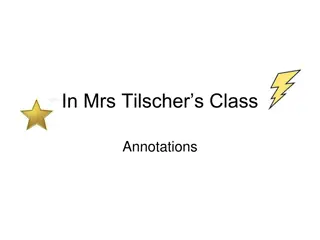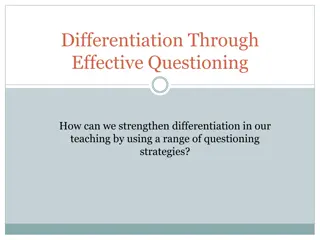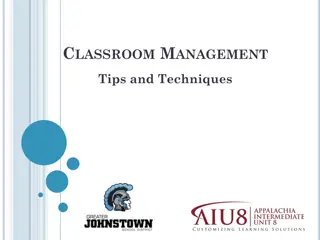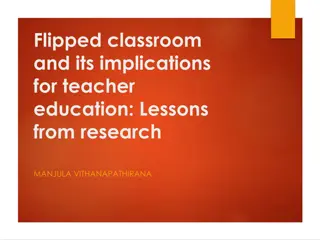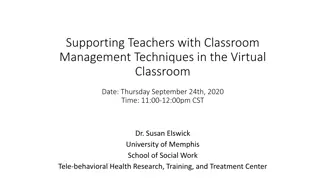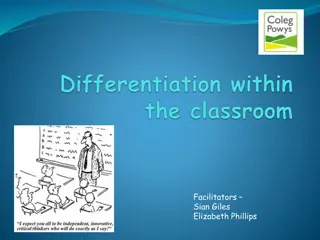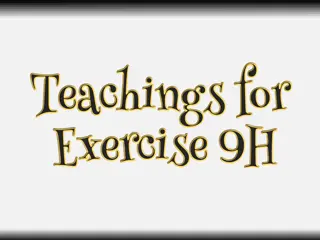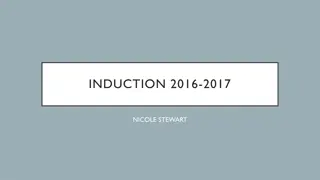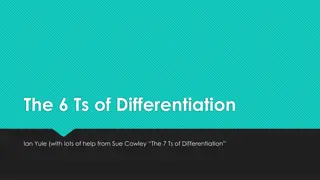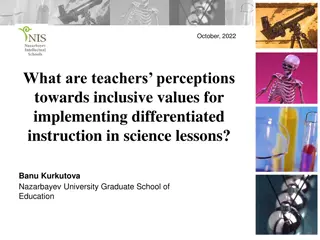Enhancing Science Learning Through Differentiation: A Primary Classroom Approach
Explore strategies for differentiating student learning in primary science classrooms, focusing on pre-testing to determine zones of proximal development. Discover methods for assessing student knowledge, understanding inquiry skills, and developing scientific concepts at various year levels.
- Science learning
- Primary classroom
- Student differentiation
- Zone of proximal development
- Inquiry skills
Download Presentation

Please find below an Image/Link to download the presentation.
The content on the website is provided AS IS for your information and personal use only. It may not be sold, licensed, or shared on other websites without obtaining consent from the author. Download presentation by click this link. If you encounter any issues during the download, it is possible that the publisher has removed the file from their server.
E N D
Presentation Transcript
Welcome to Science - Differentiating learning in the science classroom (F-6) The webinar will start promptly at 3:45pm on 6 August 2019.
Differentiating student learning in the primary science classroom The role of pre-testing in determining a student s zone of proximal development on a science learning continuum
What do your students already know? Where are your students on a learning continuum ?
Development of understanding in science Level Science as a human endeavour People use science in their daily lives Living things Movement F-2 Living things have a variety of external features and live in different places where their basic needs, including food, water and shelter, are met Living things can be grouped on the basis of observable features and can be distinguished from non-living things Living things have structural features and adaptations that help them to survive in their environment The way objects move depends on a variety of factors including their size and shape: a push or a pull affects how an object moves or changes shape 3-4 Science knowledge helps people to understand the effects of their actions Forces can be exerted by one object on another through direct contact or from a distance 5-6 Scientific understandings, discoveries and inventions are used to inform personal and community decisions and to solve problems that directly affect people s lives Energy from a variety of sources can be used to generate electricity
Development of inquiry skills in science Level Asking questions Making predictions Representations F-2 Respond to and pose questions, and make predictions With guidance, identify questions that can be investigated and predict what might happen With guidance, pose questions to inform a scientific investigation, and predict what the findings of an investigation might be Compare observations and predictions with those of others Compare results with predictions, suggesting possible reasons for findings Use provided tables to sort information 3-4 Use tables and column graphs to represent data and to identify patterns and trends Construct and use tables and graphs to record, represent and describe observations, patterns or relationships in data 5-6 Compare data with predictions and use as evidence in developing explanations
A learning continuum for questioning Learning area/ capability Levels F-2 Levels 3-4 Levels 5-6 Levels 7-8 Science Respond to and pose questions, and make predictions With guidance, identify questions that can be investigated and predict what might happen With guidance, pose questions to inform a scientific investigation, and predict what the findings of an investigation might be Identify questions, problems and claims that can be investigated scientifically and make predictions based on scientific knowledge Critical and creative thinking Identify, describe and use different kinds of question stems to gather information and ideas (e.g. what, how, when, why) Construct and use open and closed questions for different purposes (e.g. yes/no vs extended response: Is the tree deciduous? vs What makes leaves change colour?) Examine how different kinds of questions can be used to identify and clarify information, ideas and possibilities (e.g. qualitative vs quantitative) Consider how to use and approach questions that have different elements, including factual, temporal and conceptual elements
How do I know where my class of 23 students are on a learning continuum for questioning skills? KEY: = student Levels F-2 Levels 3-4 Levels 5-6 and are they in the same place in the continuum for content other than questioning skills?
Predict, observe, explain (POE): Bouncing raisins Activity: Half fill a glass or jar with water Add 2 tablespoons of vinegar and 1 tablespoon of baking soda to the water the mixture in the glass will begin to fizz Predict: Ask students to predict what will happen when five raisins are dropped into the jar Drop five raisins, one at a time, into the glass Observe: the raisins may initially sink to the bottom but eventually they will rise up and then sink, then rise again Explain: Ask students for possible reasons to explain their observations Investigate/clarify: Develop further investigations to test student ideas (or undertake research to explain the phenomenon) Curriculum ideas: chemical reactions; change of state; forces
Predict, observe, explain (POE): Freezing water Activity Fill one foam cup with cold water and one foam cup with the same amount of very hot tap water Predict: Ask students to predict which of the cups of water will freeze first Place the cups in the freezer and start the timer Check the cups every fifteen minutes Observe: The hot water freezes first Explain: Ask students for possible reasons to explain their observations Investigate/clarify: Develop further investigations to test student ideas (or undertake research to explain the phenomenon) Curriculum ideas: fair testing; heat; temperature; formal measurements; change of state
I think every child born on this planet up to the age of about four or five is fascinated by the natural world. If they aren t it s because we deprive them of the opportunity. Over half the world s population is urbanised and the thought that some children may grow up not looking at a pond or knowing how plants grow is a terrible thing. If you lose that delight and joy and intoxication, you ve lost something hugely precious. Sir David Attenborough From interview with Alice Roberts, 'Attenborough: My Life on Earth', The Biologist (Aug 2015), 62, No. 4
Leaf me alone! Sorting and classification Which criteria can be used to sort these leaves into groups? Colour? Size? Shape? Vein patterns? Smooth or serrated edges? Lobes? Moth-eaten?
Student misconceptions about plants Students may think Plants are not alive Students should think Plants are alive, even though they are different from animals and humans in many ways There are many different types of plants throughout the world, displaying many different characteristics Not all plants have the same structures (stems, leaves, flowers, roots) Plants take in air through their leaves. Chloroplasts in the plant absorb the sun s energy for use in photosynthesis. Water and minerals are taken in through the roots. Water is taken in through the roots Chloroplasts in the plant absorb the sun s energy for use in photosynthesis Water and minerals are taken in through the roots Trees, grass, vegetables, and weeds are not plants Plants take in all substances they need to grow through their roots Leaves take in water Plants get their energy from the soil through roots
Mushrooms: plant or animal? Mushrooms: are fungi, and are usually placed in a Kingdom of their own apart from plants and animals contain no chlorophyll and therefore do not carry out photosynthesis are mostly considered to be saprophytes (they obtain their nutrition from breaking down non-living organic matter build their cell walls out of chitin (same material as the hard outer shells of insects and other arthropods) whilst plants do not make chitin store nutrients and other essential compounds in their bodies, and when enough material is stored and the conditions are right they start to fruit - produce mushrooms (the part of the fungus that we see is only the fruit of the organism, and only a very small part of the whole organism) have a living body which is a mycelium (usually hidden the soil, in wood, or another food source), made out of a web of tiny, branching filaments called hyphae Question: In what ways are mushrooms similar/different from: (a) plants; (b) animals?
Pre-testing students ideas about plants Mind Maps Use the following words to create a mind map: plants; leaves; roots; soil; air; water; sun; moon Method: 1. Write each word on a small piece of paper 2. Choose two words that you can link in an idea 3. Show the link by drawing an arrow between the words and writing the link above the arrow. For example: all have plants leaves True or false? Plants are living things Plants can get water from their leaves Plants can get water from their roots Plants can get water from their stems Plants get their energy from the soil Plants get their food from the soil Weeds are plants Mushrooms are plants Seeds are non-living things 4. Add other words and links to your mind map Open questions: How do plants survive? Do plants have life cycles?
Mapping misconceptions onto a learning continuum Levels F-2 Living things have a variety of external features and live in different places where their basic needs, including food, water and shelter, are met Plants take in all substances they need to grow through their roots Leaves take in water Plants get their energy from the soil through roots Camels humps store water Levels 3-4 Living things can be grouped on the basis of observable features and can be distinguished from non-living things Levels 5-6 Living things have structural features and adaptations that help them to survive in their environment Content description Misconceptions Plants are not living things Trees, grass, vegetables, and weeds are not plants Mushrooms are plants Cactus plants have no leaves Seeds are non- living things Individuals can adapt to change in the environment if they need to (and these adaptations are inherited Lamarckian view)
Zone of proximal development concept developed by Lev Vygotsky the distance between the actual development level as determined by independent problem solving and the level of potential development as determined through problem-solving under adult guidance, or in collaboration with more capable peers (Vygotsky, Mind in society: the development of higher psychological processes, 1978, p.86) when a student is in the zone of proximal development for a particular task, providing the appropriate assistance will give the student enough of a boost to achieve the task
Supporting students to move through their zones of proximal development Strategies include: Presence of someone with knowledge and skills beyond that of the learner Social interactions with a skilful educator, or peers, that allow the learner to observe and practise their skills Scaffolding, or supportive activities provided by an educator, or more competent peer, to support the student s learning
Addressing misconceptions about plants Possible activities to develop a more sophisticated understanding of basic plants: Demonstrate: Present real examples of nonflowering plants or plants without typical features (stem, leaves, roots) Demonstrate: Present examples of plants that grow in water without soil Investigate: Germinate seeds with and without nutrients to observe the importance of nutrients in plant growth Investigate: Grow plants in light and in darkness to observe the importance of light in plant survival Investigate: Allow students to observe a variety of root structures and consider their functions Seedlings in a Jar activity: ask students to compare the mass of a closed system (jar) before and after seed germination (used to elicit student ideas about germination and plant growth as well as conservation of matter in a closed system) Discuss: Help students understand ways that plants are different from humans in form and function Science literacy: Mindfully use language to promote correct understanding, for example, avoiding the use of words such as food, eat, drink, and breathe when discussing plants
Classification systems Taxonomy (which literally means arrangement law ) is the science of classifying organisms to construct internationally shared classification systems Kingdom Animalia Fungi Plantae Protista Domain Bacteria Archae Eukaryotes Phylum What is the purpose of a classification system? How is a biological classification system similar to, and different from, the organisation of supermarket shelves? Species Family Order Class
Plant classification All plants: make their own food Vascular plants (tracheophytes): have vascular tissue (xylem and phloem) Pteridophytes Gymnosperms Seedless plants; reproduce using spores on the underside of their leaves/fronds; no flowers; no cones or seeds for reproduction Examples: ferns, horsetails pines, spruce, cypress, hemlock Non-vascular plants No vascular tissues and wood to give structural support; no true leaves, stems and roots to transport water and nutrients; narrow range of habitats; reproduce through spores Angiosperms Flowering plants; diverse over 300,000 species; vascular seed plants in which the ovule (egg) is fetrtilised and develops into a seed in an enclosed ovary Have cones instead of seeds (conifers); wood/trunks; green, needle-like foliage; ?oldest living plants on Earth Examples: mosses, liverworts, hornworts Examples: firs, Examples: trees, shrubs, bulbs, parasitic plants,
Monocots and dicots Feature Veins Monocotyledons The veins in the leaf are parallel arranged in a complex way Dicotyledons The veins in the leaf are netlike(reticulated) arranged in a ring Vascular tissue bundles Root system Flower parts Fibrous root system Flowers parts in multiples of three Pollen with a single pore Banana, Orchid, Palm Tree, Sugar cane, Ginger, Onion, Rice, Wheat, Corn, Barley Deep tap root system Flower parts in multiples of four or five Pollen with three pores Mangoes, Almonds, Beans, Peas, Pepper Pollen Examples
Marshmallow catapults support structure Materials: 5 x marshmallows masking tape 1 x rubber band 1 x plastic teaspoon 7 x bamboo skewers Step 1: Create the triangular base of your catapult using three marshmallows and three skewers. Each marshmallow will be the corners of the triangle, with the skewers forming the sides. Pierce the skewers into the marshmallows to hold it all together. Step 2: Now use three more skewers and one marshmallow to create a pyramid on top of the triangular base. Pierce a skewer into each corner marshmallow and bring all three to a point, using a marshmallow at the point to hold it all together. You may want to reinforce the point with a second rubber band wound around the three skewers to hold them together, in addition to the marshmallow. Step 2 Step 1
Marshmallow catapults - catapult mechanism Step 3 Make the catapult mechanism by taping the spoon to the final skewer. Place the rubber band over the point of the pyramid. Thread the skewer/spoon catapult through the rubber band and pierce the end into one of the corner marshmallows. Put a marshmallow onto the bowl of the spoon, bend it back against the rubber band and let it go. The marshmallow should fly through the air! Further investigations: What factors can be changed to improve the accuracy of the catapult? Step 3
Childrens ideas about rainbows Question How does a rainbow occur? Year 2 Rainbows occur when you want the sky to be beautiful after rain Rainbows occur when there are dark clouds in the sky You need sunshine for a rainbow to appear Year 4 A rainbow is all the time in the sky and sun makes it visible You need sunshine for a rainbow to appear Rainbows appear only when it rains Sun reflects on the sea and forms a rainbow Rainbows occur when the sun shines and fog is in the sky Year 6 Rainbows occur when hot and cold air come together Sun reflects on the sea and forms a rainbow Source: file:///C:/Users/08502768/Downloads/MalleusKikasKruus2016Studentsunderstan dingofcloudandrainbowformationandteachersawarenessofstudentsperformance.pdf
Misconceptions about colour The different colours appearing in coloured pictures printed in magazines and newspapers are produced by using different inks with all the corresponding colours The mixing of coloured paints and pigments follow the same rules as the mixing of colored lights The primary colours used by artists (red, yellow and blue) are the same as the primary colours for all color mixing Colour is a property of an object, and is independent of both the illuminating light and the receiver (eye) When white light passes through a colored filter, the filter adds colour to the light White light is colourless and clear, enabling you to see the "true" colour of an object When a coloured light illuminates a coloured object, the color of the light mixes with the colour of the object A coloured light striking an object produces a shadow behind it that is the same colour as the light, for example, when red light strikes an object, a red shadow is formed The shades of grey in a black and white newspaper picture are produced by using inks with different shades of grey
m%&ms what are the dye colours made up of? m&ms come in six different colours: blue; green; red; brown; yellow and orange. Question: Are the dyes pure colour, or a mixture of colours?
m&ms melt in your hand? Question: How well do m&m dyes mix?
What happens when blue and yellow m&ms are crushed together? Chocolate and other m&m parts don t appear to affect colour Mostly blue + yellow = green
How well do m&m dyes mix when physically stirred? Conclusion: Physical stirring promotes dyes mixing, but not fully Other questions: Why is it an advantage for the dyes not to mix? Do smarties behave in the same way?
Open investigation: Sink the foil boat Class challenge: construct a foil boat that will hold the most marbles Materials: 30 cm x 30 cm sheet of aluminium foil a tub of water Marbles (or anything else that can be used as weights) a mess bucket and cleaning materials optional: a scale or measuring balance https://www.fizzicseducation.com.au/150-science-experiments/force- movement-experiments/sink-the-foil-boat/ Variables to trial How can you reduce the amount of foil and still hold the same number of marbles? What happens if a liquid other than water is used? Does it matter where the weights are placed within the boat? Will twice the size of foil create a boat that can hold twice as many marbles?
Foil boat investigations Background information: This activity relates to Archimedes principle which states: Any object, wholly or partially immersed in a fluid, is buoyed up by a force equal to the weight of the fluid displaced by the object. Things float in water due to displacement and the resultant forces that act back on the object Displacement = an object pushing a liquid or gas out of the way When an object is placed into water, the object displaces the water out of the way; that same water pushes back at the object If the weight of the water that was displaced is more than the weight of the object, the object will float: this floating is due to the force of that water pushing upwards being greater than the force of the object pushing downwards If the weight of the water displaced is less than the object s weight, the object will sink: this sinking is due to the force of that water pushing upwards being lesser than the force of the object pushing downwards.
VCAA Contact Maria James Curriculum Manager, Science Email: james.maria.m@edumail.vic.gov.au Telephone: 9032 1722
Curriculum support For advice regarding the F-10 curriculum, contact VCAA F-10 Unit: E. vcaa.f10.curriculum@edumail.vic.gov.au T. 9032 1788
